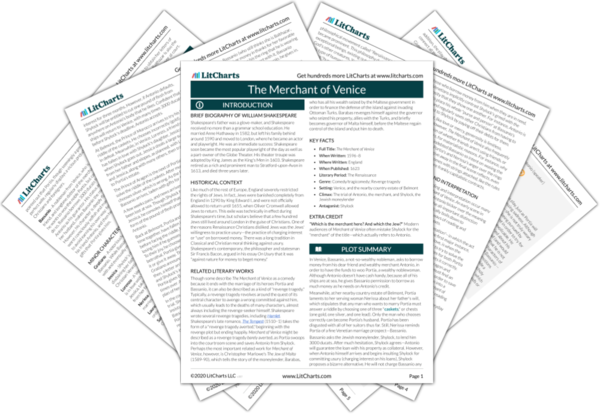Welcome to the LitCharts study guide on William Shakespeare's The Merchant of Venice. Created by the original team behind SparkNotes, LitCharts are the world's best literature guides.
The Merchant of Venice: Introduction
A concise biography of William Shakespeare plus historical and literary context for The Merchant of Venice.
The Merchant of Venice: Plot Summary
A quick-reference summary: The Merchant of Venice on a single page.
The Merchant of Venice: Detailed Summary & Analysis
In-depth summary and analysis of every scene of The Merchant of Venice. Visual theme-tracking, too.
The Merchant of Venice: Themes
Explanations, analysis, and visualizations of The Merchant of Venice's themes.
The Merchant of Venice: Quotes
The Merchant of Venice's important quotes, sortable by theme, character, or scene.
The Merchant of Venice: Characters
Description, analysis, and timelines for The Merchant of Venice's characters.
The Merchant of Venice: Symbols
Explanations of The Merchant of Venice's symbols, and tracking of where they appear.
The Merchant of Venice: Literary Devices
The Merchant of Venice's key literary devices explained and sortable by chapter.
The Merchant of Venice: Quizzes
Detailed quizzes covering every scene of The Merchant of Venice
The Merchant of Venice: Theme Wheel
An interactive data visualization of The Merchant of Venice's plot and themes.
Brief Biography of William Shakespeare
Shakespeare's father was a glove-maker, and Shakespeare received no more than a grammar school education. He married Anne Hathaway in 1582, but left his family behind around 1590 and moved to London, where he became an actor and playwright. He was an immediate success: Shakespeare soon became the most popular playwright of the day as well as a part-owner of the Globe Theater. His theater troupe was adopted by King James as the King's Men in 1603. Shakespeare retired as a rich and prominent man to Stratford-upon-Avon in 1613, and died three years later.
Get the entire The Merchant of Venice LitChart as a printable PDF.

Historical Context of The Merchant of Venice
Like much of the rest of Europe, England severely restricted the rights of Jews. In fact, Jews were banished completely from England in 1290 by King Edward I, and were not officially allowed to return until 1655, when Oliver Cromwell allowed Jews to return. This exile was technically in effect during Shakespeare's time, but scholars believe that a few hundred Jews still lived around London in the guise of Christians. One of the reasons Renaissance Christians disliked Jews was the Jews' willingness to practice usury—the practice of charging interest or "use" on borrowed money. There was a long tradition in Classical and Christian moral thinking against usury. Shakespeare's contemporary, the philosopher and statesman Sir Francis Bacon, argued in his essay On Usury that it was "against nature for money to beget money."
Other Books Related to The Merchant of Venice
Though some describe The Merchant of Venice as a comedy because it ends with the marriage of its heroes Portia and Bassanio, it can also be described as a kind of "revenge tragedy." Typically, a revenge tragedy revolves around the quest of its central character to avenge a wrong committed against him, which usually leads to the deaths of many characters, almost always including the revenge-seeker himself. Shakespeare wrote several revenge tragedies, including Hamlet. Shakespeare's late romance, The Tempest (1510–1) takes the form of a "revenge tragedy averted," beginning with the revenge plot but ending happily. Merchant of Venice might be described as a revenge tragedy barely averted, as Portia swoops into the courtroom scene and saves Antonio from Shylock. Perhaps the most important related work for Merchant of Venice, however, is Christopher Marlowe's The Jew of Malta (1589-90), which tells the story of the moneylender, Barabas, who has all his wealth seized by the Maltese government in order to finance the defense of the island against invading Ottoman Turks. Barabas revenges himself against the governor who seized his property, allies with the Turks, and briefly becomes governor of Malta himself, before the Maltese regain control of the island and put him to death.
Key Facts about The Merchant of Venice
- Full Title: The Merchant of Venice
- When Written: 1596–8
- Where Written: England
- When Published: 1623
- Literary Period: The Renaissance
- Genre: Comedy/tragicomedy; Revenge tragedy
- Setting: Venice, and the nearby country estate of Belmont
- Climax: The trial of Antonio, the merchant, and Shylock, the Jewish moneylender
- Antagonist: Shylock
Extra Credit for The Merchant of Venice
"Which is the merchant here? And which the Jew?" Modern audiences of Merchant of Venice often mistake Shylock for the "merchant" of the title—which actually refers to Antonio.












